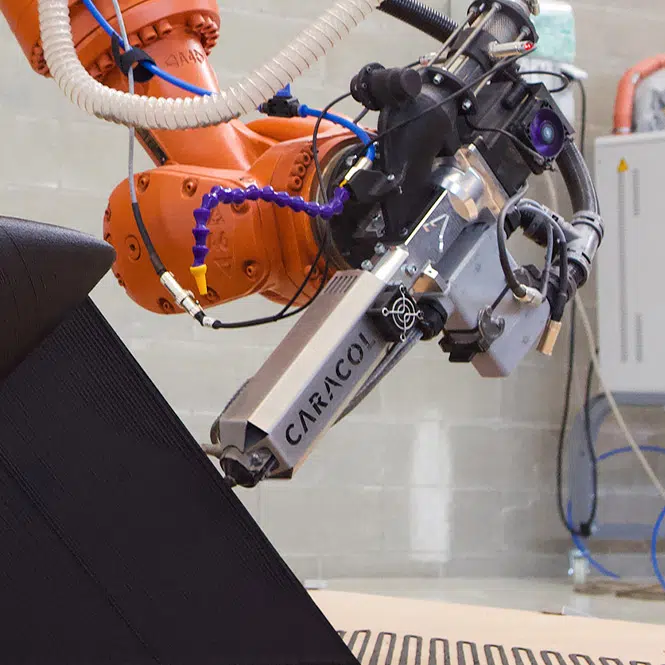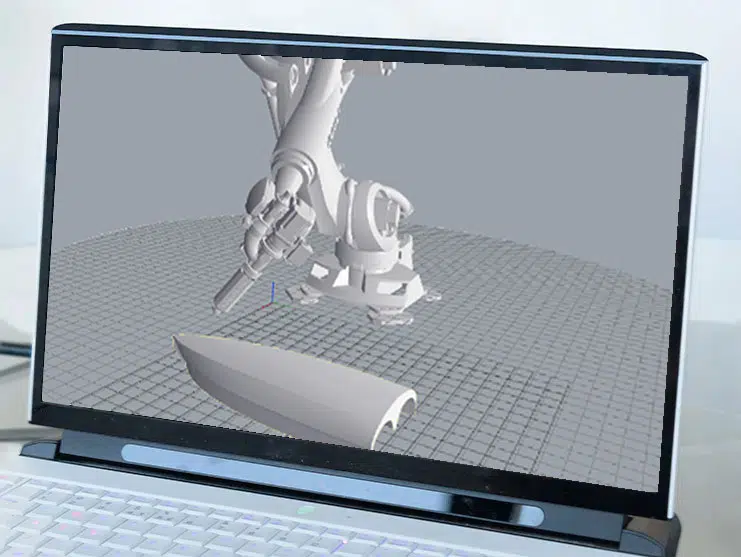The Benefits of Large Format 3D Printing
-
FLEXIBILITY is freedom in customizing parts’ design and geometries. Directly from 3D CAD design to production, Caracol LFAM technologies empower manufacturers to transform their ideas into reality.
-
EFFICIENCY means faster time to market and lower costs. Optimized manufacturing processes result in shorter lead times and reduced operating costs without compromising on parts’ mechanical and functional properties.
-
SUSTAINABILITY of the entire process with zero-to-positive environmental impact: drastically cutting waste, using only needed raw and recycled material, limiting the need for storage, supports or tools, manufacturing on-demand with a digital library to limit impact of logistics, and making circular economy possible.

Additive Manufacturing Software
Eidos Manufacturing
Multifunctional software to manage and control parts production through the entire additive manufacturing workflow.
Discover EidosFAQ
What is Additive Manufacturing and how does 3D printing work? Read more on definitions, technologies, examples, and tips in our Frequently Asked Questions. Learn more on Caracol’s solutions for large format industrial 3D printing.
-
What type of manufacturing is 3D printing?
3D printing is an innovative manufacturing process that builds three-dimensional objects through the extrusion of material (plastic, metal, ceramics, and many more) layer upon layer, starting from a digital model. Also known as Additive Manufacturing, 3D printing is opposed to the traditional “subtractive” manufacturing methods that machine the final components by cutting away material. This new process leads to a more efficient production with less material wastage and to a greater design freedom, allowing to experiment with complex geometries that were once considered challenging or impossible to produce through conventional means. Explore more on AM technologies.
-
What is Additive Manufacturing process?
Additive Manufacturing, commonly known as 3D printing, is a transformative process that builds objects layer by layer, through the deposition of a variety of materials including plastics, metals, ceramics, and even biomaterials on a digital 3D model. This innovative technology stands in contrast to traditional subtractive manufacturing, offering unparalleled design freedom and efficiency to produce lighter, stronger parts and systems used across a variety of industries.
-
Is there a difference between Additive Manufacturing and 3D printing?
There is a distinction between Additive Manufacturing and 3D printing, although the terms are often used interchangeably. Additive Manufacturing (AM) is the process that encompasses various techniques, with 3D printing being one of them. Additive Manufacturing refers to the method of creating objects by adding material layer by layer, based on a digital model. This process eliminates material waste and allows for complex and customized designs. 3D printing specifically refers to the Additive Manufacturing technology that uses printers to create physical objects from digital files. In essence, 3D printing is a subcategory of Additive Manufacturing.
-
How does Additive Manufacturing differentiate from other technologies?
Additive Manufacturing (AM) stands apart from traditional manufacturing methods due to its revolutionary approach. Unlike subtractive manufacturing that involves cutting away material from a solid block, AM constructs objects layer by layer using digital designs. Thanks to Additive Manufacturing technology, it is possible to create complex geometries and intricate designs with utmost precision by cutting waste and lead time through an environmentally friendly and cost-efficient process.
-
How many Additive Manufacturing types exist?
Additive Manufacturing encompasses a diverse array of techniques, each of them tailored to specific materials and applications, offering unique advantages and targeting specific precision requirements and industry needs. While new techniques may emerge, currently several prominent Additive Manufacturing technologies are applied to industrial contexts. Just to cite a few: Fused Deposition Modeling (FDM), Stereolithography (SLA), Selective Laser Sintering (SLS), Binder Jetting, Direct Metal Laser Sintering (DMLS). Explore more on AM technologies.
-
Which are the main benefits of Additive Manufacturing?
Additive Manufacturing offers a multitude of compelling advantages across industries. Some key benefits include design freedom; rapid prototyping and iteration; high customization; use of wide variety of materials; waste reduction; shorter lead time and cost-reduction, also for low volume production; supply chain efficiency and sustainability. Its potential to reshape manufacturing through innovation, efficiency, and sustainability is remarkable. Explore more on Additive Manufacturing applications and its advantages.
-
What does LFAM mean?
LFAM stands for “Large Format Additive Manufacturing“, a cutting-edge technology within the realm of Additive Manufacturing. It refers to the capability of producing significantly larger objects and components, compared to traditional Additive Manufacturing techniques. LFAM systems, such as Caracol integrated platform HERON AM, are used to create large-scale components by layer-by-layer material deposition based on digital designs. This technology has gained attention across industries such as architecture and construction, automotive, aerospace, marine and railway. By enabling the creation of entire building components, vehicle parts, and even aircraft structures and tooling, LFAM pushes the boundaries of design possibilities and manufacturing efficiency.
-
Why choosing LFAM solutions to produce parts?
Opting for Large Format Additive Manufacturing solutions means transforming the way parts are created, providing substantial benefits across industries. The compelling advantages of LFAM technology for the production of lighter yet robust components are: scalability, design flexibility, higher customization, reduced waste, faster and cost-efficient production, reduced tooling costs, no need of complex assembly, supply chain optimization, and innovative applications.
-
Which are the main industries using LFAM technology?
LFAM (Large Format Additive Manufacturing) technology is applied on several advanced industries that are revolutionizing the way products are designed, manufactured, and utilized. The main sectors harnessing LFAM’s capabilities are aerospace, defence, automotive, marine, railway, architecture and construction, furniture and design consumer goods, energy and renewables, arts and entertainment, research and academia. Enabling innovative designs and contributing to overall efficiency, LFAM’s influence is likely to expand further, opening new avenues for applications and growth.

